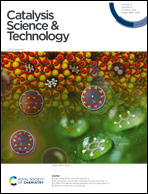Constructing green mercury-free catalysts with single pyridinic N species for acetylene hydrochlorination and mechanism investigation†
Abstract
Mercury chloride is a key catalyst for acetylene hydrochlorination to produce vinyl chloride, which is the main raw material for the manufacture of PVC. However, the extensive use of mercury has caused serious environmental problems. Herein, a green poly(o-phenylenediamine) framework was synthesized for acetylene hydrochlorination. The polymer is composed of a phenazine backbone with defined pyridinic N species, which is an ideal model system for the study of the catalytic role of pyridinic N in the reaction. The polymer has bifunctional properties. When acting as a polymer catalyst, it achieved ≈95% conversion of acetylene at 280 °C and exhibited a satisfying stability during a 100 h continuous test. Active sites and reaction paths on the pyridinic N structure were well explored through catalytic experiments, spectroscopic characterizations, and density functional theory calculations. As an important extension of its application, the polymer was then used as a suitable precursor to prepare an N-doped carbon catalyst. The polymer-derived carbon catalyst exhibited surprising acetylene hydrochlorination activity, which was comparable to that of a 6 wt% Hg/C catalyst. This work proposes a new strategy for constructing highly efficient mercury-free catalysts with target active species and will contribute to the sustainable development of the PVC industry.



 Please wait while we load your content...
Please wait while we load your content...